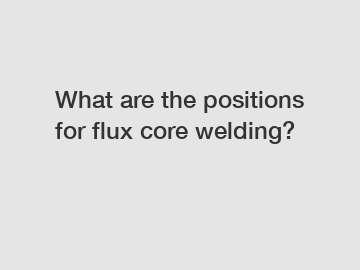What are the positions for flux core welding?
Flux core welding, also known as FCAW (Flux-Cored Arc Welding), is a popular welding process that uses a continuously fed wire electrode and a flux-filled core. This type of welding is commonly used in various industries due to its versatility and ability to handle thick metals or materials with rust or dirt on the surface. However, to perform flux core welding efficiently, it is crucial to understand the different positions that can be used. In this article, we will explore the various positions for flux core welding, providing you with a comprehensive overview of this welding technique.
1. Flat Position.
The flat position is the most common and easiest position for flux core welding. In this position, the welder aims to create a weld bead that is flat and wide. The electrode is held at a 90-degree angle relative to the joint, allowing the molten metal to flow evenly across the joint. Welding in the flat position is often used for applications such as sheet metal fabrication, construction, and general repair work.

2. Horizontal Position.
In the horizontal position, the weld joint is positioned horizontally, and the electrode is held at a slight upward angle of 5-15 degrees. The molten metal should flow evenly and smoothly from the electrode to create a sound weld. This position is commonly used for welding pipes, containers, and structural components where the joint is positioned horizontally.
3. Vertical Position.
When welding in the vertical position, the weld joint is positioned vertically, and the electrode is held at a 90-degree angle to the joint. This position requires precise control and skill as the molten metal tends to flow downward due to gravity. The welder needs to manipulate the electrode and control the arc to ensure the molten metal does not sag or create cold laps. Vertical position welding is often used for applications such as construction, shipbuilding, and pipeline fabrication.
4. Overhead Position.
The overhead position is the most challenging position for flux core welding. In this position, the joint is positioned overhead, and the welder needs to weld from the underside, holding the electrode at a 5-15-degree downward angle. The molten metal needs to be carefully controlled to prevent it from falling or splattering. Overhead welding is commonly used for applications such as bridge construction, repair work, and certain manufacturing processes.
In addition to the primary positions mentioned above, various combinations and variations can be achieved by rotating or inclining the weld joint. These include:
- Vertical-up Position: Welding vertically with an upward progression.
- Vertical-down Position: Welding vertically with a downward progression.
- Flat-horizontal Position: Welding in a flat position with the joint positioned horizontally.
- Flat-vertical Position: Welding in a flat position with the joint positioned vertically.
It is important to note that each welding position requires specific techniques, equipment settings, and skill sets. Welders should receive proper training and practice to master these positions efficiently.
In conclusion, flux core welding offers flexibility and effectiveness in various welding applications. Mastering the different welding positions is essential for producing high-quality welds and ensuring structural integrity. Whether it's the flat, horizontal, vertical, or overhead position, each requires precision, control, and understanding of the welding process. By recognizing the unique demands of each position, welders can produce strong and reliable welds for their projects.
If you have any further questions about flux core welding or would like to explore other welding techniques, please do not hesitate to contact us. We are always here to assist you with your welding needs.
Are you interested in learning more about Chromium Carbide Steel Plate, wear resistant steel plate manufacturers, hard face mig wire? Contact us today to secure an expert consultation!
267
0
0

Comments
All Comments (0)